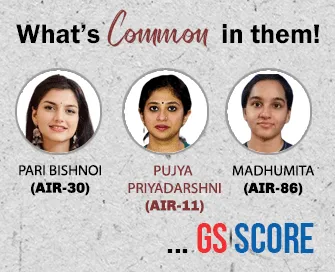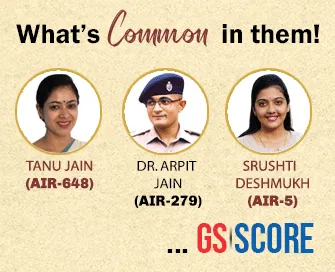

2nd September 2023 (8 Topics)
Editorials
Context:
Though the GDP growth rate and factors influencing it, seems to be fine as per projections by the Reserve Bank of India (RBI), however there exists potential risks and uncertainties in India's economic landscape like inflation and agricultural concerns still exists.
India's Economic Growth in Q1
- Promising Q1 Growth: India's Q1 GDP growth reached 7.8%, slightly below the RBI's 8% projection, signaling robust economic performance.
- Future Concerns: The RBI foresees a gradual growth decline in 2023, hitting 5.7% in Q4. However, experts remain optimistic about the 6.5% annual target.
- India's Comparative Advantage: Despite global challenges, India maintains its status as the fastest-growing major economy, surpassing China's 6.3% growth, despite domestic issues.
Challenges in Different Sectors
- Agriculture's Mixed Prospects: Q1 showed a 3.5% growth in agriculture, but concerns loom due to a tepid monsoon and low reservoir levels, posing threats to upcoming crops.
- Services Sector Resilience: Services, particularly trade and transport, witnessed robust growth. However, employment remains below pre-COVID levels, signaling an incomplete recovery.
- Manufacturing and Consumption Challenges: Manufacturing improved slightly, but widespread consumption recovery is awaited. Private spending increased, mainly by high earners, while persistent food inflation may harm lower-income segments and rural demand.
Risks and Outlook
- Balancing Inflation and Growth: Export restrictions on rice and onions to curb inflation could harm economic growth and trade balance.
- Fiscal Risks of Relief Measures: Lowering LPG cylinder prices may jeopardize fiscal stability and long-term economic growth prospects.
- Future Economic Outlook: The months ahead may pose challenges, with global factors impacting exports and manufacturing, alongside domestic pressures. The RBI's Monetary Policy Committee's upcoming decisions are pivotal.


Editorials
Context:
China's economic slowdown sparks concerns of deflation, raising questions about its future and global ramifications, necessitating a deeper understanding.
The Growth Strategy:
- Premier's Caution: In 2007, Premier Wen Jiabao cautioned about China's unsustainable economic growth characterized by instability and imbalance.
- Infrastructure Investment: China responded to the warning by investing heavily in infrastructure, including railways and energy sectors, to sustain prosperity.
- Domestic Legitimacy: China's leaders relied on high economic growth to maintain domestic legitimacy and create prosperity for its citizens.
Focus of China:
- Shift to Quality of Life: In 2017, President of China redirected their focus towards improving citizens' quality of life, recognizing changing expectations.
- End of High Growth Era: China's previous reliance on double-digit growth from exports and infrastructure spending came to an end.
- Economic Challenges: Lower growth rates resulted in job scarcity, rising unemployment, and the necessity for political decisions to tackle these economic challenges.
Political Economy and Reforms:
- Role of China's Political Economy: China's political economy exerts substantial influence on economic policies and decisions, impacting innovation and economic dynamics
- Complex Economic Landscape: Recent factors, including trade conflicts, pandemic responses, and housing market challenges, have further complicated China's economic environment.
- State-Owned Enterprises (SoEs) and Path-Dependency: The presence of SoEs and path-dependency issues in China's economic structure necessitate careful consideration and reform efforts.


Editorials
Context:
Recognition of fungi as a part of the ‘flora, fauna, funga’ trinity was long overdue. Studying and protecting them on equal footing with plants and animals is crucial.
Fungi and Uses
- About:Fungi are diverse microorganisms crucial in ecosystems, aiding decomposition, forming mutualistic partnerships with plants, and offering medicinal, industrial, and ecological benefits.
- Medicinal Marvels: Fungi have given us essential antibiotics like penicillin and produce compounds with anti-cancer and antiviral properties.
- Biotechnological Wonders: They are used in various industrial processes, including brewing, baking, and the production of enzymes and biofuels.
Recognizing Fungi's Importance
- Fungi's Ecological Significance: Fungi play a pivotal role in ecosystems, contributing to pollution cleanup, facilitating plant communication, and offering sustainable solutions.
- Underappreciated Kingdom: Despite their importance, the majority of fungal species lack documentation, with only 10% characterized. Recognizing fungi's role alongside flora and fauna is vital for addressing future challenges.
- Conservation Imperative: Understanding and conserving fungi can have far-reaching environmental benefits, emphasizing the need for increased research and protection efforts.
Unlocking Fungal Potential
- Fungi's Diverse Capabilities: Fungi demonstrate remarkable versatility, contributing to pollution remediation, producing valuable compounds (antiviral, anti-cancer), and offering sustainable materials like mushroom-based alternatives to styrofoam.
- Neglected Natural Assets: Beyond culinary and medicinal fungi, the vast majority of fungal species receive insufficient attention. There is a pressing need to expand research and conservation initiatives.
- Safeguarding Earth's Future: Recognizing and harnessing the potential of fungi can address pressing environmental concerns. Greater emphasis on research and conservation can contribute to a more sustainable future.


Editorials
Context:
After the criticism to temple visit of ISRO chairman, his reply mentioned that exploring the inner space is as relevant as for outer space. In contrast to pre-Enlightenment Western religions, Dharmic traditions encourage questioning and exploring instead of blind faith.
Recognizing Spiritual Exploration
- ISRO's Temple Visits: Debate over ISRO scientists visiting temples sparked discussions on scientific temper and spirituality. In India, spiritual exploration aligns with scientific inquiry, emphasizing seeking and scepticism.
- Dharmic Tradition: India's spiritual tradition, rooted in seeking and exploration, doesn't rely on blind faith. Swami Vivekananda advocated religious scrutiny through scientific investigation.
- Complementary Paths: While science delves into the physical world, spirituality explores innate human values beyond quantifiable measures, fostering unity and awareness.
Balancing Scientific and Spiritual Quests
- Limitations of Rationalism: Even staunch rationalists like Jawaharlal Nehru found solace in spirituality. He highlighted ethical aspects and an appeal beyond logic.
- Cosmic Exploration: As humanity advances in cosmic exploration, the balance between conquering nature and seeking inner understanding becomes crucial for our evolution.
- Universal Naming: Naming celestial bodies after deities transcends religions. Planets and missions draw from various mythologies, emphasizing cultural and cosmic significance.
Relation between Science and Spirituality
- Complementary Paths: Science and spirituality can coexist, offering distinct but complementary ways of understanding the world and our existence.
- Exploring Inner and Outer Realms: While science investigates the physical universe, spirituality delves into consciousness and inner experiences.
- Shared Values: Both realms can promote values like curiosity, humility, and a deep appreciation for the mysteries of existence.



